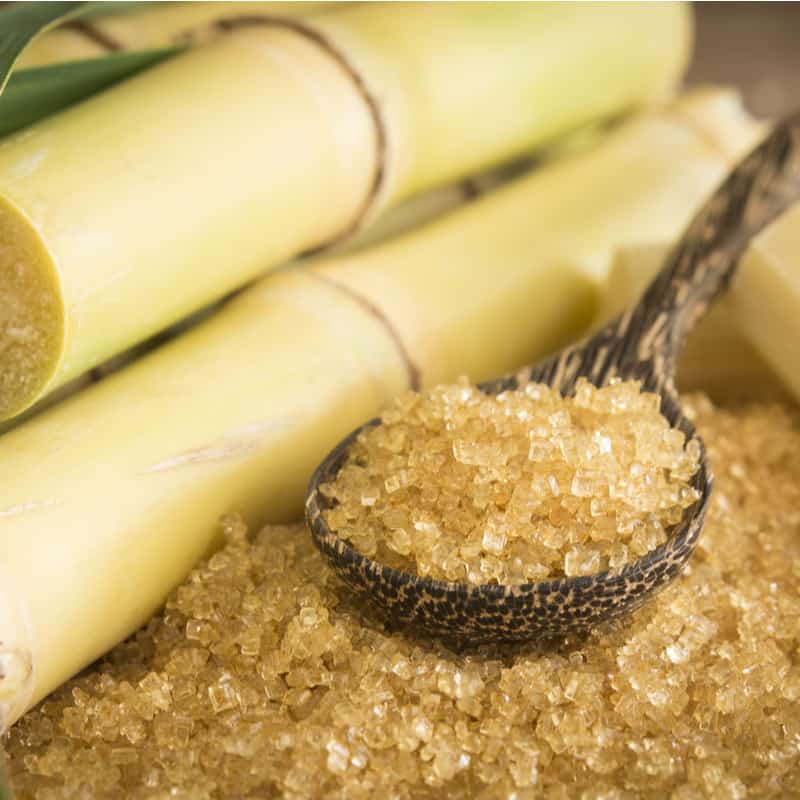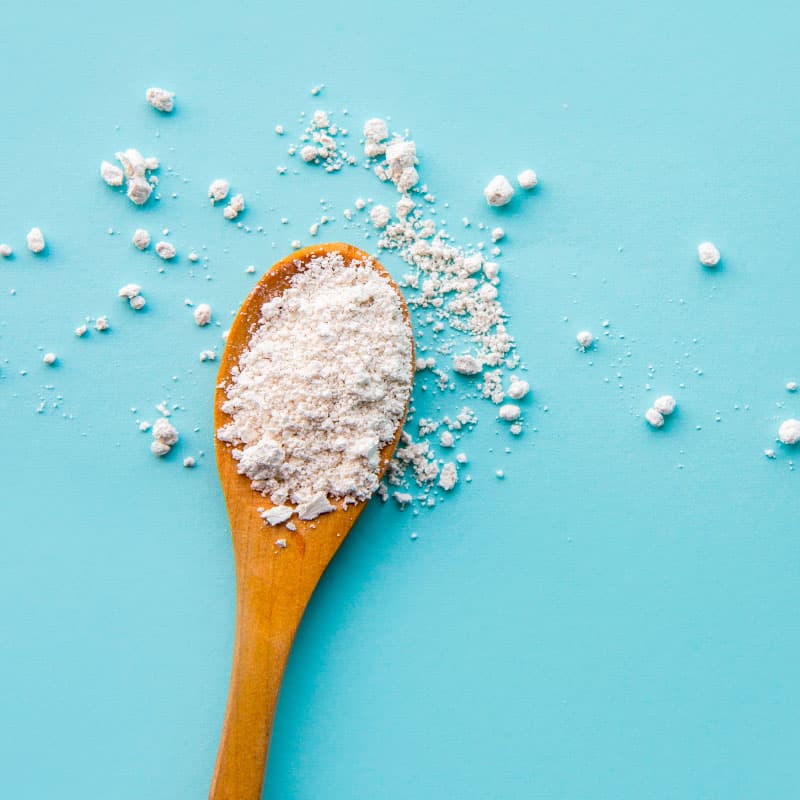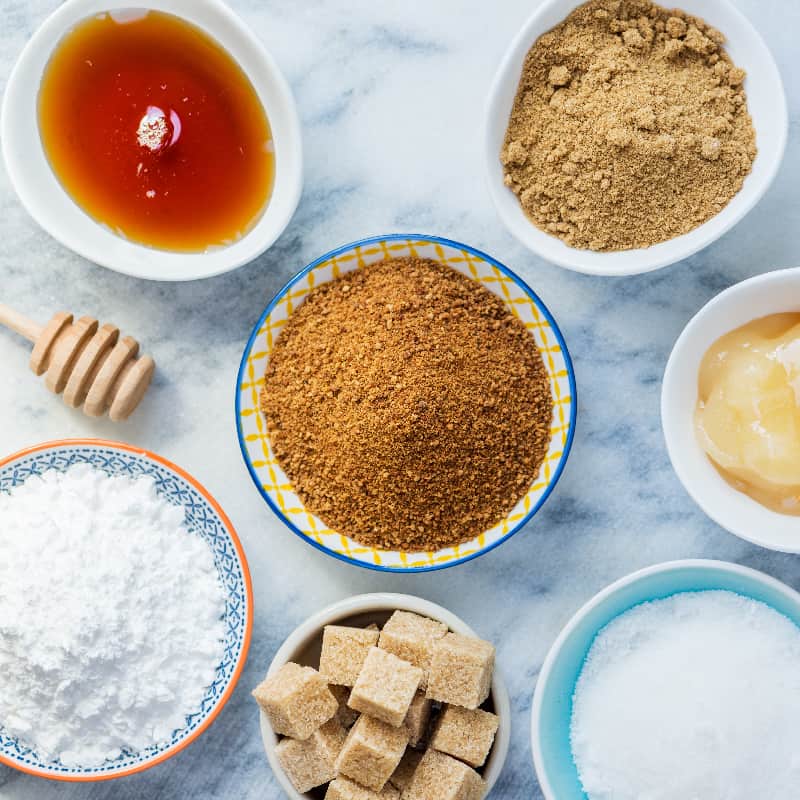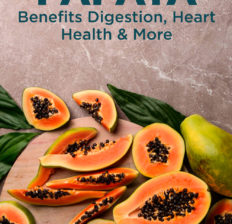This Dr. Axe content is medically reviewed or fact checked to ensure factually accurate information.
With strict editorial sourcing guidelines, we only link to academic research institutions, reputable media sites and, when research is available, medically peer-reviewed studies. Note that the numbers in parentheses (1, 2, etc.) are clickable links to these studies.
The information in our articles is NOT intended to replace a one-on-one relationship with a qualified health care professional and is not intended as medical advice.
This article is based on scientific evidence, written by experts and fact checked by our trained editorial staff. Note that the numbers in parentheses (1, 2, etc.) are clickable links to medically peer-reviewed studies.
Our team includes licensed nutritionists and dietitians, certified health education specialists, as well as certified strength and conditioning specialists, personal trainers and corrective exercise specialists. Our team aims to be not only thorough with its research, but also objective and unbiased.
The information in our articles is NOT intended to replace a one-on-one relationship with a qualified health care professional and is not intended as medical advice.
Papaya Benefits Digestion, Heart Health & More
July 25, 2025
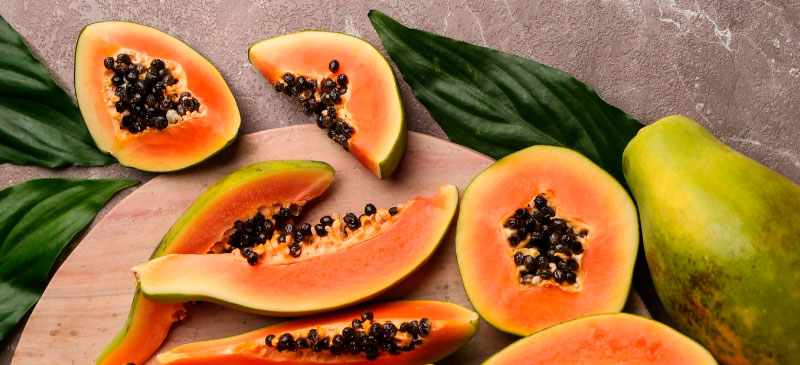
Christopher Columbus was known to call papaya the “fruit of the angels.” It’s a fitting name considering this fruit is rich in antioxidants, enzymes, vitamins and fiber, and papaya benefits everything from digestion and immune function to skin health and heart wellness.
Whether you enjoy it fresh, blended into smoothies or added to salads, the benefits of papaya make it a valuable addition to almost any diet. Let’s explore the top papaya benefits, how to enjoy it safely and why this vibrant fruit deserves a spot on your plate.
Papaya benefits
Papayas have long been used in many forms of traditional medicine. The fruit is thought to offer benefits in the treatment of a wide variety of health conditions.
In many parts of the world, for instance, the papaya fruit is believed to help naturally treat malaria, E. coli and parasitic infections.
According to Ayurveda, papaya can help alkalize the body, reduce inflammation and strengthen the function of the spleen. It’s also thought to nourish the body, enhance energy levels, and improve vision and eye health.
Lucky for all of us, simply adding this fruit to your diet can provide a range of health benefits, including the following papaya benefits:
1. Promotes proper digestion
Certain papaya enzyme compounds can help the body break down and use proteins properly. Papain, in particular, helps break apart the bonds between amino acids.
It is similar to other types of enzymes made in the pancreas that help our bodies digest meat, but unlike other enzymes, it can work even without the presence of acid. Therefore, due to its ability to break apart amino acids, this papaya enzyme can be helpful for people struggling with low stomach acid who may not be able to tolerate consuming certain types of meat.
It also can promote protein absorption in those with other digestive issues.
Eating papaya can also help prevent constipation due to its high fiber content. Fiber adds bulk to the stool and eases its excretion out of the body.
In fact, a 2012 review published in the World Journal of Gastroenterology found that increasing fiber intake was effective at increasing stool frequency in people with constipation to help promote regularity.
2. Soothes inflammation
Inflammation is a natural immune response designed to fend off foreign invaders and protect against illness and infection. However, chronic inflammation is at the root of most diseases, and it is believed to contribute to serious conditions like heart disease, cancer, diabetes and more.
A 2011 study published in the journal of Molecular Nutrition and Food Research found that inflammatory markers decreased when test subjects were given papaya. Researchers found it may help reduce inflammation and relieve symptoms for people with certain conditions, such as rheumatoid arthritis. It is noted, however, that further research is needed.
Papain has also been shown to help decrease inflammation in people with diseases such as asthma or arthritis. Not only can papayas lower levels of inflammation slow the progression of chronic disease, but they may also help naturally reverse signs of aging as well.
3. Strengthens the blood
Papaya has garnered a good amount of attention as a blood strengthener to help people who have a medical condition called thrombocytopenia, or low blood platelets. This is a dangerous medical condition that can reduce the body’s ability to form blood clots and potentially lead to internal bleeding.
An animal study out of Malaysia conducted on mice concluded that those given papaya leaf extract had significantly higher platelet and red blood cell counts after 72 hours compared to those in a control group. Although additional information is still needed, researchers believe that papaya extract may eventually be used as a treatment for people with blood disorders and impaired blood clotting.
In addition, a randomized, clinical trial involving prediabetic participants evaluated the effects of daily supplementation with six grams of fermented papaya preparation (FPP) for 14 weeks. The study found that compared to baseline:
- FPP significantly reduced the susceptibility of red blood cells to oxidative hemolysis (i.e., less breakdown of erythrocytes).
- It also reduced levels of protein carbonyls in the blood plasma, markers of oxidative damage.
- Overall, total antioxidant status in the blood increased markedly, indicating strengthened antioxidant defense in vivo.
4. Enhances heart health
Papayas are loaded with vitamin C, which is an important micronutrient that acts as an antioxidant to protect against free radical damage. It also protects against the oxidation of cholesterol, reducing the ability of cholesterol to form plaque along the artery walls.
Some research has found that a deficiency in vitamin C may be linked to a greater risk of death from heart disease, although additional information is needed to determine the exact mechanism. Papaya also contains folate, which can help convert homocysteine, a type of amino acid that has been linked to heart disease, into other amino acids to reduce the risk of heart problems.
5. May have anti-cancer properties
Several compounds found in ripe and unripe papaya have been shown to have powerful anti-cancer effects. Papaya seed extract, for example, has been shown to block the growth and spread of human colon cancer cells in lab studies.
Meanwhile, vitamin C and beta-carotene, both of which are found in papaya, have been linked to a decreased risk of several different types of cancer. Plus, papain has displayed anti-tumor effects against human cholangiocarcinoma cell lines.
Plus, in addition to promoting regularity, studies have shown that increasing your intake of dietary fiber may also be associated with a lower risk of colorectal cancer.

6. Can help prevent macular degeneration and protect vision
Each serving of papaya packs in a hearty dose of beta-carotene, one of the primary nutrients involved in preserving vision and protecting eye health.
It also contains lutein and zeaxanthin, two flavonoids that can help prevent macular degeneration, or age-related loss of vision. Zeaxanthin specifically helps filter out blue light that can be harmful to the retina to optimize vision even as you get older.
7. May help prevent asthma
In addition to keeping vision healthy, beta-carotene has been shown to help reduce the risk of asthma. Maintaining adequate levels of vitamin A in the diet may be especially crucial for children to help reduce airway inflammation.
8. Slows signs of aging
Due to the high levels of vitamin C, vitamin A and other flavonoids, papayas are a great fruit to help keep the skin healthy and wrinkle-free. Research has shown that these nutrients work as antioxidants that help prevent free radical formation and oxidative damage to the skin, both of which are considered some of the leading causes of aging.
9. Fights viral infections
Papaya leaves have been used to treat dengue fever, a deadly viral infection from mosquitos in tropical areas. In one particular study, the leaves were mixed with water and given to patients twice a day. The treatment was found to significantly decrease viral activity after five days.
Traditional Polynesian cultures in Hawaii and Tahiti made poultices out of papaya skin to help with wound healing. Why? The skin is particularly high in papain.
They would apply the poultice directly to the skin to treat burns, rashes or bug bites.
Papain also can be used to treat fungal and viral infections of the skin, such as warts and ringworm. It helps destroy the layer of protein that protects viruses and fungi against attack, decreasing their ability to reproduce and spread.
10. Strengthens bone health
Papaya contains important nutrients like vitamin K, magnesium and calcium, which all support bone density and strength. Vitamin K in particular plays a key role in calcium absorption and bone mineralization, helping reduce the risk of fractures and osteoporosis as you age.
Regular consumption of papaya may support skeletal health, especially when combined with a balanced diet and physical activity.
11. Protects skin and hair health
Papaya is rich in antioxidants like vitamin C and beta-carotene, which help protect skin cells from oxidative stress and UV damage. Vitamin C is essential for collagen production, helping maintain skin elasticity and reduce signs of aging, such as wrinkles and sagging.
The vitamin A content in papaya also supports scalp health and may promote hair growth by nourishing hair follicles and improving circulation.
12. Suitable for diabetics
Although papaya is naturally sweet, it has a relatively low glycemic index, making it a suitable fruit for people with diabetes when eaten in moderation. Its fiber content can help regulate blood sugar levels and improve insulin sensitivity.
Additionally, the antioxidants in papaya may help reduce oxidative stress, a major contributor to diabetes complications.
13. May help slow Alzheimer’s
Preliminary research has suggested that the antioxidants in fermented papaya, especially a compound called fermented papaya preparation, may help protect the brain from oxidative damage linked to Alzheimer’s disease. These antioxidants may help counteract the buildup of amyloid plaques and reduce inflammation in the brain, though more human studies are needed to confirm these effects.
14. Boosts immunity
Thanks to its high vitamin C content, papaya benefits include its role as a powerful immune booster. It also contains vitamin A, folate, and small amounts of zinc and vitamin E, all of which contribute to a healthy immune response.
Regularly eating papaya can help your body fight infections and recover more quickly from illnesses like colds or the flu.
Papaya seeds also have their own nutritional benefits. They can be eaten as well, although they are quite bitter.
The seeds have been used as a folk medicine to treat parasitic infections, E. coli and other viral and bacterial infections.
Nutrition facts
This orange-colored, melon-like fruit is part of the Caricaceae family of plants and grows on the Carica papaya tree.
It’s native to southern Mexico and Central America but can be grown in most tropical areas. When ripe, it is commonly used around the world to make juice or as a delicious addition to salads, salsa or desserts. Not only that, but it is also commonly used as a meat tenderizer or digestive enzyme as well.
Papaya, similar to but different than pawpaw, contains a special enzyme called papain. Papain is why it is most known to work as a powerful digestive aid.
Improved digestion and helping the body detox aren’t the only benefits of papaya. It can also help improve heart health, reduce inflammation, strengthen the blood and so much more.
Like other types of tropical fruit, it’s also high in multiple vitamins, minerals, flavonoids and antioxidants. Plus, it is used around the world to boost overall health in a number of incredible ways.
It’s believed that papaya was first grown in Southern Mexico and Central American regions. Spanish explorers are thought to be the first to come across papaya seeds and the edible sweet fruit. They brought them along during travels through Central America, India and other Pacific Islands.
Today, papaya is grown around the world in many different tropical areas. India, Indonesia, Brazil, Nigeria, Mexico, the United States and many Central American nations are the largest producers.
The popularity of using this fruit in recipes around the world has only continued to increase over the past few decades, which is a good thing given the numerous papaya benefits.
Papayas are a nutrient-dense food. That means each serving contains a low amount of calories but a high amount of vitamins, minerals and antioxidants.
In particular, the fruit is a good source of vitamin C and vitamin A. It also provides a good dose of folate and potassium.
A one-cup serving of raw papaya (about 145 grams) contains approximately:
- Calories: 62.4
- Total Carbohydrates: 15.7 g
- Fiber: 2.5 g
- Sugar: 11.3 g
- Total Fat: 0.4 g
- Saturated Fat: 0.1 g
- Polyunsaturated Fat: 0.1 g
- Monounsaturated Fat: 0.1 g
- Trans Fat: 0 g
- Protein: 0.7 g
- Sodium: 11.6 mg (0.5% DV*)
- Vitamin C: 88.2 mg (98% DV)
- Folate: 53.6 mcg (13% DV)
- Vitamin A: 68.2 mcg (8% DV)
- Potassium: 264 mg (6% DV)
*Daily Value: Percentages are based on a diet of 2,000 calories a day.
In addition to the nutrients listed above, papayas also contains a small amount of vitamin E, vitamin K, thiamine, riboflavin, pantothenic acid and calcium.
It’s common to compare tropical fruits, such as papaya, mango, pineapple, guava and banana, which are beloved for their delicious flavor and signature sweetness. All are also rich in nutrients, offering a wealth of vitamin C, potassium, vitamin A, fiber, antioxidants and more.
However, there are also many distinct differences that set them apart.
- Mango is a type of stone fruit that belongs to the cashew family of plants, and it has become a popular ingredient used to make juices, smoothies, ice creams and chutneys.
- Pineapple is a fruit produced by a herbaceous perennial, and it’s often enjoyed as a snack in salads and sweets. It’s used to balance out savory dishes like pizza or burgers as well.
- Guava is commonly enjoyed in Central and South America. It can be found added to beverages, candies, homemade bars or desserts. It can also be eaten raw or seasoned with just a pinch of salt or cayenne pepper.
- Bananas, which are technically considered berries, are native to southeast Asia and Australia. Closely related to the plantain, bananas are usually consumed when fully ripe. They can be enjoyed raw or added to desserts, smoothies, breakfast dishes and more.
Recipes
Although it was once difficult to find papayas in regions outside of their tropical habitat, you can now find them at most major supermarkets when in season.
There are two main varieties of this fruit: Mexican and Hawaiian. The Mexican type can grow up to 10 pounds in size, whereas the Hawaiian one is generally smaller. Both have a sweet, orange-colored flesh and dark, gelatinous seeds on the inside.
When unripe, the flesh is green and can only be eaten if cooked. Green papaya is used for stir-fries and curries in many Asian dishes.
As it ripens, it develops its yellow-orange color and its signature sweetness. A ripe papaya has orange skin that gives a little when pushed.
If you purchase a papaya to eat the same day, choose one that has a reddish-orange skin and is softer. It may take a few days out on the counter to ripen if it’s still yellow on the outside.
It’s best eaten at room temperature, which allows the sweet flavors and familiar papaya taste to develop. If you plan to dice it up, be sure to eat as soon as it is cut for the maximum amount of flavor.
Wondering how to eat papaya to take advantage of the many micronutrients and benefits of papaya? There are plenty of different ways to enjoy it:
- Whip up a healthy papaya salad.
- Make papaya juice.
- Eat it raw with a squeeze of lemon to enhance the flavor.
There are many online tutorials for how to cut a papaya, but it typically just involves cutting the fruit lengthwise, scooping out the seeds and cutting the flesh of the fruit away from the skin.
The seeds are usually discarded, but they are also edible. They are slightly spicy and can be used as a pepper substitute in salad dressings and other sauces.
Need an idea for how to bring the delicious flavor of papaya into your daily diet? Try this Tropical Acai Bowl to get your started.
Risks and side effects
Papaya may cause allergic reactions in people allergic to latex. Papayas and other fruits contain a substance called chitinase, which is associated with cross-reactions between latex and fruit.
Green papaya contains the most potential for allergic reactions and should not be eaten raw.
Many people also wonder: Can dogs eat papaya? While it can be a tasty treat for your furry friends, be sure to cut it into small pieces, and avoid letting them eat the seeds to prevent digestive issues.
Additionally, papaya is vulnerable to a few widespread viruses and fungi, including a variety of papaya ringworm. In an effort to combat this problem, researchers began conducting experiments on the seeds to see if genetically altering them could provide protection against these harmful viruses.
Researchers were successful in creating a strand of genetically modified papaya seeds that were more resilient to pests and bacteria. In turn, they produced Rainbow papaya and SunUp papaya, two varieties that now make up 80 percent of the papaya grown in Hawaii, one of the world’s biggest producers.
While it is still possible to find non-GMO papaya sold in the U.S., you need to ensure you purchase an organic variety in order to know that it has not been modified in any way. There are several health concerns associated with GMO crops, ranging from allergic reactions to antibiotic resistance, so opt for non-GMO fruit whenever possible.
Frequently asked questions
What are the top health benefits of papaya?
Papaya benefits include supporting digestion, enhancing immunity, promoting skin and eye health, improving heart health, and potentially protecting against cognitive decline and diabetes.
Is it safe to eat papaya every day?
Yes, eating papaya daily in moderation can be beneficial. It’s packed with nutrients and antioxidants, but those with latex allergies or who are pregnant should consult a doctor first.
Is papaya good for weight loss?
Yes, papaya is low in calories and high in fiber and water content, making it a great fruit for promoting satiety and supporting healthy weight management.
Can papaya be eaten on an empty stomach?
Yes, papaya is gentle on the stomach and can aid in digestion when eaten first thing in the morning due to its enzyme content, particularly papain.
Though papaya is generally fine on an empty stomach, some people may experience mild digestive sensitivity due to its active enzymes. If you have a sensitive stomach, pair it with other foods, or consume it mid-morning.
Is papaya good for your liver?
Papaya may support liver health by reducing oxidative stress and inflammation, especially when consumed as part of a nutrient-dense, anti-inflammatory diet.
Are there any risks to eating papaya?
While papaya is generally safe, unripe papaya contains latex, which may trigger allergic reactions in sensitive individuals and should be avoided during pregnancy. Eating large quantities may also lead to digestive upset or diarrhea due to its high fiber and enzyme content.
Is it safe to eat papaya seeds?
Papaya seeds are edible and may offer antibacterial and liver-supporting benefits. However, they are potent and should be consumed in small amounts. Overconsumption may lead to digestive irritation or toxicity in some cases.
When should you eat papaya?
Papaya can be enjoyed any time of day, but it’s especially beneficial in the morning to support digestion or after meals to help break down proteins. It’s best eaten ripe for optimal taste and enzyme activity.
Is papaya very high in sugar?
Papaya contains natural sugars but has a moderate glycemic index and is relatively low in sugar compared to other tropical fruits.
Conclusion
- Papaya is a type of fruit derived from the papaya tree that is native to Mexico and northern South America.
- It is low in calories but packs tons of fiber, vitamin C, vitamin A and folate into each serving.
- There are numerous potential papaya benefits, including enhanced digestion, reduced inflammation, better heart health and more.
- There are also many different ways to enjoy papayas. Some of the most popular include adding it to salads or smoothies, making it into a juice, or eating it raw with just a squeeze of lemon to take advantage of papaya benefits.
- Selecting organic, non-GMO fruit and including it as part of a healthy, balanced diet is a great way to take advantage of papaya benefits.




